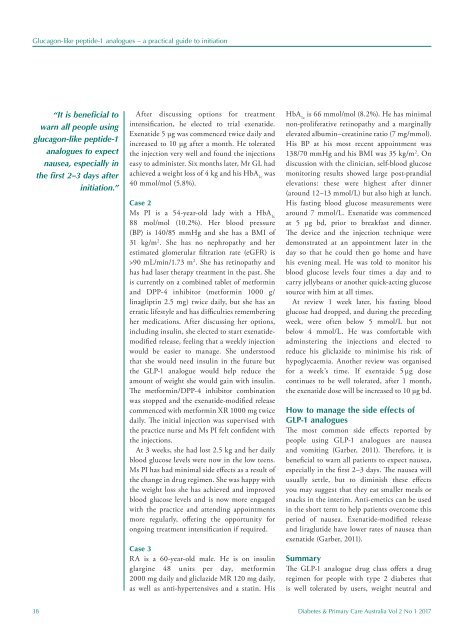DPCA2-1
Create successful ePaper yourself
Turn your PDF publications into a flip-book with our unique Google optimized e-Paper software.
Glucagon-like peptide-1 analogues – a practical guide to initiation<br />
“It is beneficial to<br />
warn all people using<br />
glucagon-like peptide-1<br />
analogues to expect<br />
nausea, especially in<br />
the first 2–3 days after<br />
initiation.”<br />
After discussing options for treatment<br />
intensification, he elected to trial exenatide.<br />
Exenatide 5 µg was commenced twice daily and<br />
increased to 10 µg after a month. He tolerated<br />
the injection very well and found the injections<br />
easy to administer. Six months later, Mr GL had<br />
achieved a weight loss of 4 kg and his HbA 1c<br />
was<br />
40 mmol/mol (5.8%).<br />
Case 2<br />
Ms PI is a 54-year-old lady with a HbA 1c<br />
88 mol/mol (10.2%). Her blood pressure<br />
(BP) is 140/85 mmHg and she has a BMI of<br />
31 kg/m 2 . She has no nephropathy and her<br />
estimated glomerular filtration rate (eGFR) is<br />
>90 mL/min/1.73 m 2 . She has retinopathy and<br />
has had laser therapy treatment in the past. She<br />
is currently on a combined tablet of metformin<br />
and DPP-4 inhibitor (metformin 1000 g/<br />
linagliptin 2.5 mg) twice daily, but she has an<br />
erratic lifestyle and has difficulties remembering<br />
her medications. After discussing her options,<br />
including insulin, she elected to start exenatidemodified<br />
release, feeling that a weekly injection<br />
would be easier to manage. She understood<br />
that she would need insulin in the future but<br />
the GLP-1 analogue would help reduce the<br />
amount of weight she would gain with insulin.<br />
The metformin/DPP-4 inhibitor combination<br />
was stopped and the exenatide-modified release<br />
commenced with metformin XR 1000 mg twice<br />
daily. The initial injection was supervised with<br />
the practice nurse and Ms PI felt confident with<br />
the injections.<br />
At 3 weeks, she had lost 2.5 kg and her daily<br />
blood glucose levels were now in the low teens.<br />
Ms PI has had minimal side effects as a result of<br />
the change in drug regimen. She was happy with<br />
the weight loss she has achieved and improved<br />
blood glucose levels and is now more engaged<br />
with the practice and attending appointments<br />
more regularly, offering the opportunity for<br />
ongoing treatment intensification if required.<br />
Case 3<br />
RA is a 60-year-old male. He is on insulin<br />
glargine 48 units per day, metformin<br />
2000 mg daily and gliclazide MR 120 mg daily,<br />
as well as anti-hypertensives and a statin. His<br />
HbA 1c<br />
is 66 mmol/mol (8.2%). He has minimal<br />
non-proliferative retinopathy and a marginally<br />
elevated albumin–creatinine ratio (7 mg/mmol).<br />
His BP at his most recent appointment was<br />
138/70 mmHg and his BMI was 35 kg/m 2 . On<br />
discussion with the clinician, self-blood glucose<br />
monitoring results showed large post-prandial<br />
elevations: these were highest after dinner<br />
(around 12–13 mmol/L) but also high at lunch.<br />
His fasting blood glucose measurements were<br />
around 7 mmol/L. Exenatide was commenced<br />
at 5 µg bd, prior to breakfast and dinner.<br />
The device and the injection technique were<br />
demonstrated at an appointment later in the<br />
day so that he could then go home and have<br />
his evening meal. He was told to monitor his<br />
blood glucose levels four times a day and to<br />
carry jellybeans or another quick-acting glucose<br />
source with him at all times.<br />
At review 1 week later, his fasting blood<br />
glucose had dropped, and during the preceding<br />
week, were often below 5 mmol/L but not<br />
below 4 mmol/L. He was comfortable with<br />
adminstering the injections and elected to<br />
reduce his gliclazide to minimise his risk of<br />
hypoglycaemia. Another review was organised<br />
for a week’s time. If exentaide 5 µg dose<br />
continues to be well tolerated, after 1 month,<br />
the exenatide dose will be increased to 10 µg bd.<br />
How to manage the side effects of<br />
GLP-1 analogues<br />
The most common side effects reported by<br />
people using GLP-1 analogues are nausea<br />
and vomiting (Garber, 2011). Therefore, it is<br />
beneficial to warn all patients to expect nausea,<br />
especially in the first 2–3 days. The nausea will<br />
usually settle, but to diminish these effects<br />
you may suggest that they eat smaller meals or<br />
snacks in the interim. Anti-emetics can be used<br />
in the short term to help patients overcome this<br />
period of nausea. Exenatide-modified release<br />
and liraglutide have lower rates of nausea than<br />
exenatide (Garber, 2011).<br />
Summary<br />
The GLP-1 analogue drug class offers a drug<br />
regimen for people with type 2 diabetes that<br />
is well tolerated by users, weight neutral and<br />
38 Diabetes & Primary Care Australia Vol 2 No 1 2017
















